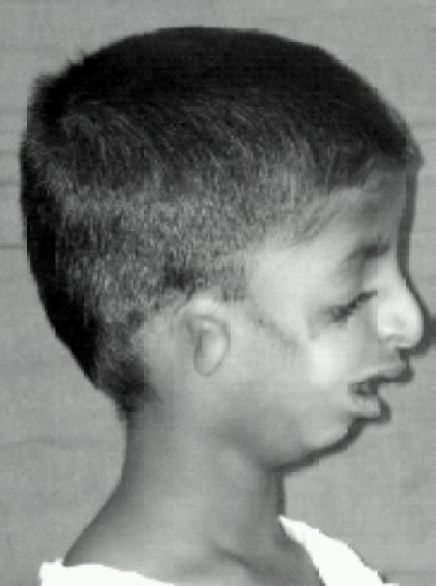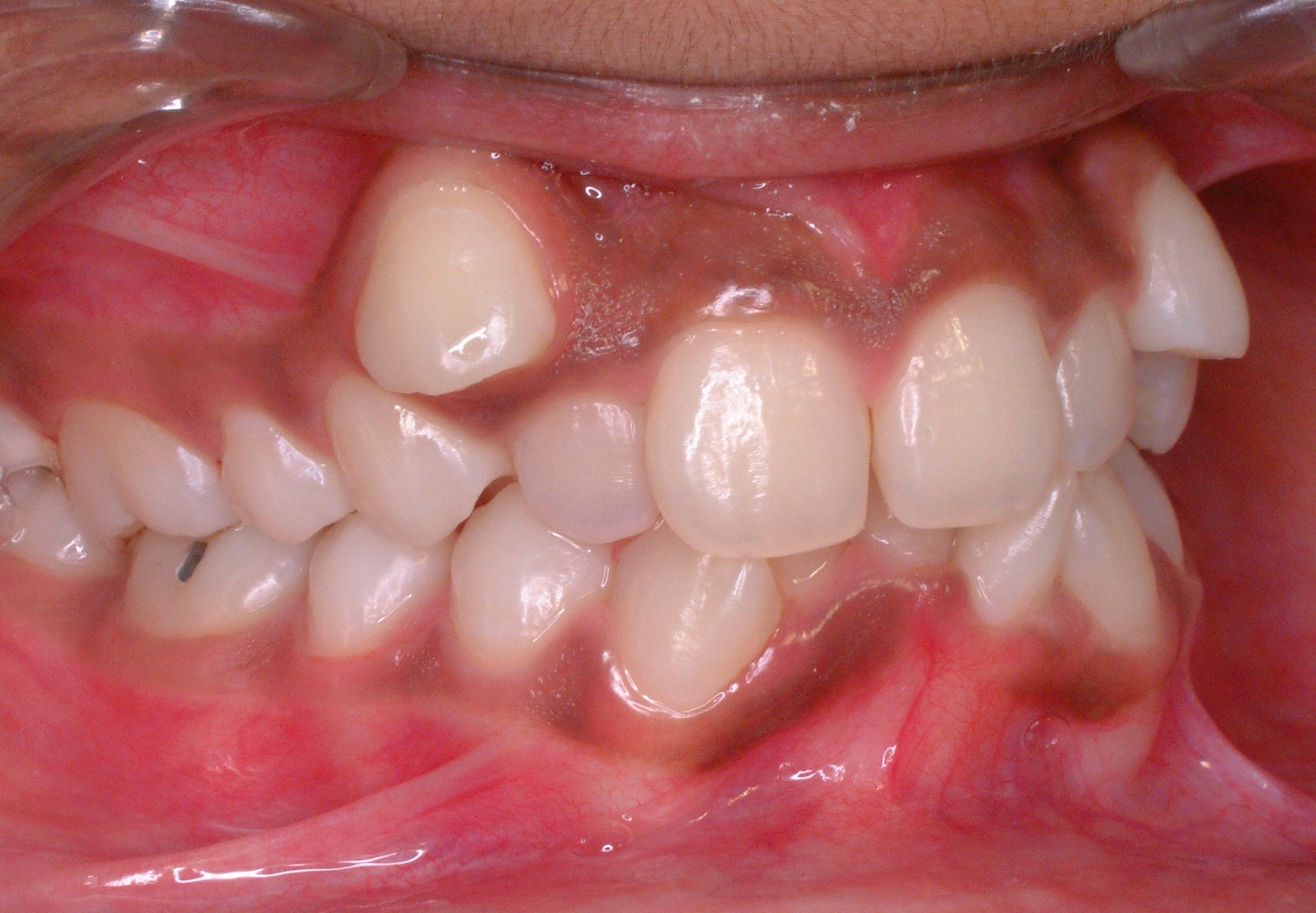|
Retrognathism
Retrognathia is a type of malocclusion which refers to an abnormal posterior positioning of the maxilla or mandible, particularly the mandible, relative to the facial skeleton and soft tissues. A retrognathic mandible is commonly referred to as an overbite, though this terminology is not used medically. See also * Micrognathism * Prognathism Prognathism, also called Habsburg jaw or Habsburgs' jaw primarily in the context of its prevalence amongst members of the House of Habsburg, is a positional relationship of the mandible or maxilla to the skeletal base where either of the jaws pr ... References External links Diagram at brooksideorthodontics.com - see Classification of Face:Class 2 section Jaw disorders {{disease-stub ... [...More Info...] [...Related Items...] OR: [Wikipedia] [Google] [Baidu] |
Micrognathism
Micrognathism is a condition where the jaw is undersized. It is also sometimes called mandibular hypoplasia. It is common in infants, but is usually self-corrected during growth, due to the jaws' increasing in size. It may be a cause of abnormal tooth alignment and in severe cases can hamper feeding. It can also, both in adults and children, make intubation difficult, either during anesthesia or in emergency situations. Causes While not always pathological, it can present as a birth defect in multiple syndromes including: * Catel–Manzke syndrome * Bloom syndrome * Coffin–Lowry syndrome * Congenital rubella syndrome * Cri du chat syndrome * DiGeorge syndrome * Ehlers–Danlos syndrome * Fetal alcohol syndrome * Hallermann–Streiff syndrome * Hemifacial microsomia (as part of Goldenhar syndrome) * Incontinentia pigmenti * Juvenile idiopathic arthritis * Marfan syndrome * Möbius syndrome * Noonan syndrome * Pierre Robin syndrome * Prader–Willi syndrome * Progeria * Silve ... [...More Info...] [...Related Items...] OR: [Wikipedia] [Google] [Baidu] |
Treacher Collins Syndrome
Treacher Collins syndrome (TCS) is a genetic disorder characterized by deformities of the ears, eyes, cheekbones, and chin. The degree to which a person is affected, however, may vary from mild to severe. Complications may include breathing problems, problems seeing, cleft palate, and hearing loss. Those affected generally have normal intelligence. TCS is usually autosomal dominant. More than half the time it occurs as a result of a new mutation rather than being inherited from a person's parents. The involved genes may include ''TCOF1'', ''POLR1C'', or ''POLR1D''. Diagnosis is generally suspected based on symptoms and X-rays, and potentially confirmation by genetic testing. Treacher Collins syndrome is not curable. Symptoms may be managed with reconstructive surgery, hearing aids, speech therapy, and other assistive devices. Life expectancy is generally normal. TCS occurs in about one in 50,000 people. The syndrome is named after Edward Treacher Collins, an English surgeon an ... [...More Info...] [...Related Items...] OR: [Wikipedia] [Google] [Baidu] |
Microtia
Microtia is a congenital deformity where the auricle (external ear) is underdeveloped. A completely undeveloped pinna is referred to as anotia. Because microtia and anotia have the same origin, it can be referred to as microtia-anotia. Microtia can be unilateral (one side only) or bilateral (affecting both sides). Microtia occurs in 1 out of about 8,000–10,000 births. In unilateral microtia, the right ear is most commonly affected. It may occur as a complication of taking Accutane (isotretinoin) during pregnancy. Classification According to the Altman-classification, there are four grades of microtia: *Grade I: A less than complete development of the external ear with identifiable structures and a small but present external ear canal *Grade II: A partially developed ear (usually the top portion is underdeveloped) with a closed stenotic external ear canal producing a conductive hearing loss. *Grade III: Absence of the external ear with a small peanut-like vestige structure a ... [...More Info...] [...Related Items...] OR: [Wikipedia] [Google] [Baidu] |
Medical Genetics
Medical genetics is the branch tics in that human genetics is a field of scientific research that may or may not apply to medicine, while medical genetics refers to the application of genetics to medical care. For example, research on the causes and inheritance of genetic disorders would be considered within both human genetics and medical genetics, while the diagnosis, management, and counselling people with genetic disorders would be considered part of medical genetics. In contrast, the study of typically non-medical phenotypes such as the genetics of eye color would be considered part of human genetics, but not necessarily relevant to medical genetics (except in situations such as albinism). ''Genetic medicine'' is a newer term for medical genetics and incorporates areas such as gene therapy, personalized medicine, and the rapidly emerging new medical specialty, predictive medicine. Scope Medical genetics encompasses many different areas, including clinical practice of ... [...More Info...] [...Related Items...] OR: [Wikipedia] [Google] [Baidu] |
Dentistry
Dentistry, also known as dental medicine and oral medicine, is the branch of medicine focused on the teeth, gums, and mouth. It consists of the study, diagnosis, prevention, management, and treatment of diseases, disorders, and conditions of the mouth, most commonly focused on dentition (the development and arrangement of teeth) as well as the oral mucosa. Dentistry may also encompass other aspects of the craniofacial complex including the temporomandibular joint. The practitioner is called a dentist. The history of dentistry is almost as ancient as the history of humanity and civilization with the earliest evidence dating from 7000 BC to 5500 BC. Dentistry is thought to have been the first specialization in medicine which have gone on to develop its own accredited degree with its own specializations. Dentistry is often also understood to subsume the now largely defunct medical specialty of stomatology (the study of the mouth and its disorders and diseases) for which reas ... [...More Info...] [...Related Items...] OR: [Wikipedia] [Google] [Baidu] |
Malocclusion
In orthodontics, a malocclusion is a misalignment or incorrect relation between the teeth of the upper and lower dental arches when they approach each other as the jaws close. The English-language term dates from 1864; Edward Angle (1855-1930), the "father of modern orthodontics", popularised it. The word "malocclusion" derives from ''occlusion'', and refers to the manner in which opposing teeth meet ('' mal-'' + ''occlusion'' = "incorrect closure"). The malocclusion classification is based on the relationship of the mesiobuccal cusp of the maxillary first molar and the buccal groove of the mandibular first molar. If this molar relationship exists, then the teeth can align into normal occlusion. According to Angle, malocclusion is any deviation of the occlusion from the ideal. However, assessment for malocclusion should also take into account aesthetics and the impact on functionality. If these aspects are acceptable to the patient despite meeting the formal definition of ... [...More Info...] [...Related Items...] OR: [Wikipedia] [Google] [Baidu] |
Maxilla
The maxilla (plural: ''maxillae'' ) in vertebrates is the upper fixed (not fixed in Neopterygii) bone of the jaw formed from the fusion of two maxillary bones. In humans, the upper jaw includes the hard palate in the front of the mouth. The two maxillary bones are fused at the intermaxillary suture, forming the anterior nasal spine. This is similar to the mandible (lower jaw), which is also a fusion of two mandibular bones at the mandibular symphysis. The mandible is the movable part of the jaw. Structure In humans, the maxilla consists of: * The body of the maxilla * Four processes ** the zygomatic process ** the frontal process of maxilla ** the alveolar process ** the palatine process * three surfaces – anterior, posterior, medial * the Infraorbital foramen * the maxillary sinus * the incisive foramen Articulations Each maxilla articulates with nine bones: * two of the cranium: the frontal and ethmoid * seven of the face: the nasal, zygomatic, lacrimal, inferior n ... [...More Info...] [...Related Items...] OR: [Wikipedia] [Google] [Baidu] |
Human Mandible
In anatomy, the mandible, lower jaw or jawbone is the largest, strongest and lowest bone in the human facial skeleton. It forms the lower jaw and holds the lower tooth, teeth in place. The mandible sits beneath the maxilla. It is the only movable bone of the skull (discounting the ossicles of the middle ear). It is connected to the temporal bones by the temporomandibular joints. The bone is formed prenatal development, in the fetus from a fusion of the left and right mandibular prominences, and the point where these sides join, the mandibular symphysis, is still visible as a faint ridge in the midline. Like other symphyses in the body, this is a midline articulation where the bones are joined by fibrocartilage, but this articulation fuses together in early childhood.Illustrated Anatomy of the Head and Neck, Fehrenbach and Herring, Elsevier, 2012, p. 59 The word "mandible" derives from the Latin word ''mandibula'', "jawbone" (literally "one used for chewing"), from ''wikt:mandere ... [...More Info...] [...Related Items...] OR: [Wikipedia] [Google] [Baidu] |
Overbite
Overbite is the extent of vertical ( superior-inferior) overlap of the maxillary central incisors over the mandibular central incisors, measured relative to the incisal ridges. The term overbite does not refer to a specific condition, nor is it a form of malocclusion. Rather an absent or excess overbite would be a malocclusion. Normal overbite is not measured in exact terms, but as a proportion (approximately 30–50% of the height of the mandibular incisors) and is commonly expressed as a percentage. Other terms confused with "overbite" Overbite is often confused with overjet, which is the distance between the maxillary anterior teeth and the mandibular anterior teeth in the anterior-posterior axis. "Overbite" may also be used commonly to refer to Class II malocclusion or retrognathia, though this usage can be considered incorrect. This is where the mesiobuccal cusp of the maxillary first molar is situated anterior to the buccal groove of the mandibular first molar; in o ... [...More Info...] [...Related Items...] OR: [Wikipedia] [Google] [Baidu] |
Prognathism
Prognathism, also called Habsburg jaw or Habsburgs' jaw primarily in the context of its prevalence amongst members of the House of Habsburg, is a positional relationship of the mandible or maxilla to the skeletal base where either of the jaws protrudes beyond a predetermined imaginary line in the coronal plane of the skull. In general dentistry, oral and maxillofacial surgery, and orthodontics, this is assessed clinically or radiographically ( cephalometrics). The word ''prognathism'' derives from Greek πρό (''pro'', meaning 'forward') and γνάθος (''gnáthos'', 'jaw'). One or more types of prognathism can result in the common condition of malocclusion, in which an individual's top teeth and lower teeth do not align properly. Presentation Prognathism in humans can occur due to normal variation among phenotypes. In human populations where prognathism is not the norm, it may be a malformation, the result of injury, a disease state or a hereditary condition. Prognathism ... [...More Info...] [...Related Items...] OR: [Wikipedia] [Google] [Baidu] |


.jpg)



